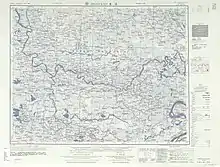Tsienkiang
English

Map including CH’IEN-CHIANG (TSIENKIANG) 潛江 (AMS, 1953) →OCLC
Alternative forms
- Tsienkiáng
Etymology
From the Postal Romanization of Mandarin 潛江/潜江 (Qiánjiāng).
Proper noun
Tsienkiang
- (historical or obsolete) Alternative form of Qianjiang
- 2015, Jack R. Lundbom, “Preaching, Evangelism, and Establishing a Chinese Church”, in On the Road to Siangyang: Covenant Mission in Mainland China 1890-1949 (Studies in Chinese Christianity), Eugene, Oregon: Pickwick Publications, →ISBN, →OCLC, page 53:
- When this became too heavy a load for the seminary teacher, Oscar Anderson came with his family in the fall of 1932¹⁷⁵ to join in evangelism and relief work in Kingchow, Tsienkiang, and the outstations. […]
In the fall of 1934 Oscar Anderson and Pastor Tang made visits to Tsienkiang, a district between Kingchow and Hankow, and found there Christians who were still firm in their faith after visitations by the communists, and more people now who wanted to become Christian.
Further reading
- Leon E. Seltzer, editor (1952), “Tsienkiang or Ch’ien-chiang”, in The Columbia Lippincott Gazetteer of the World, Morningside Heights, NY: Columbia University Press, →OCLC, page 1952, column 3
This article is issued from Wiktionary. The text is licensed under Creative Commons - Attribution - Sharealike. Additional terms may apply for the media files.